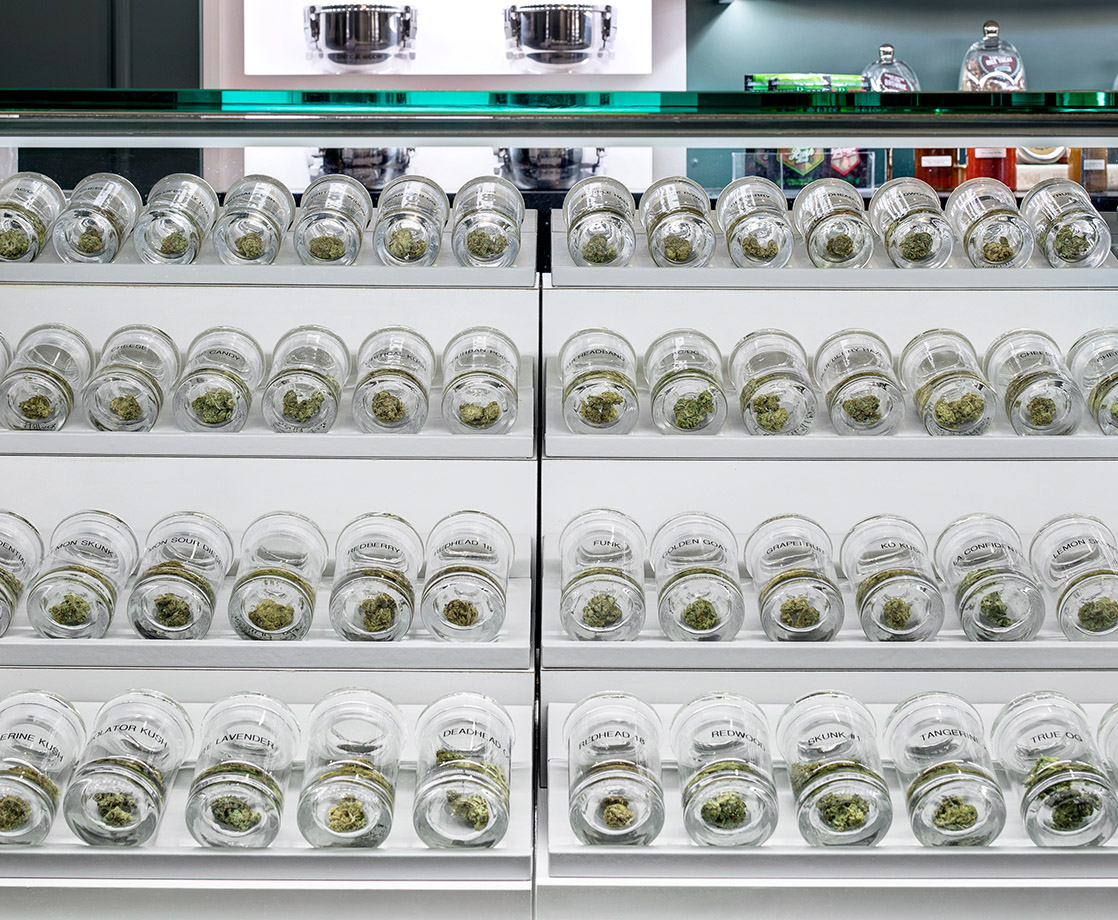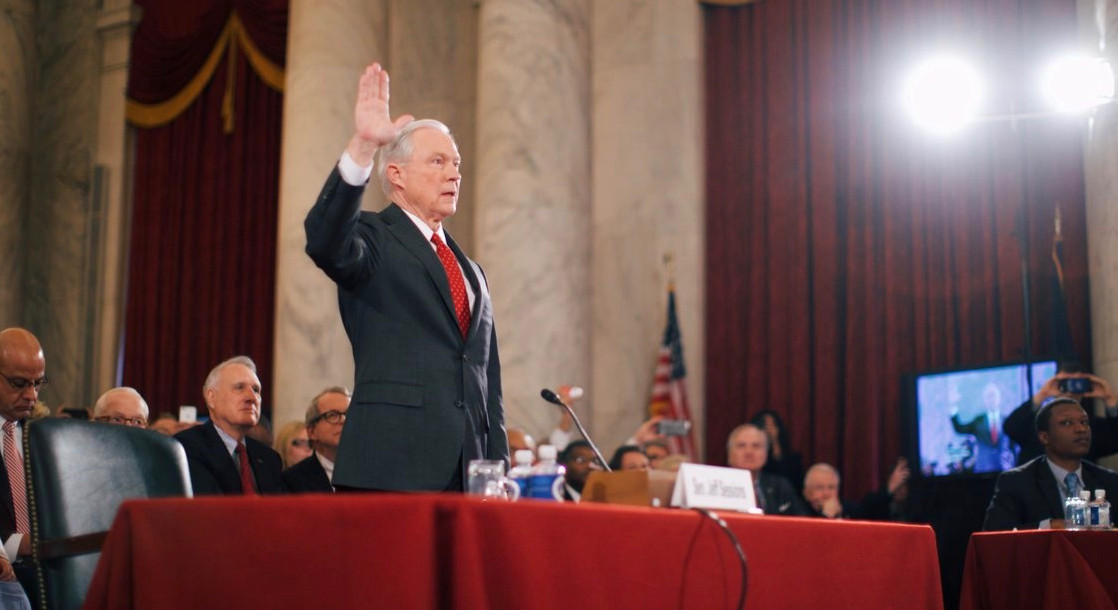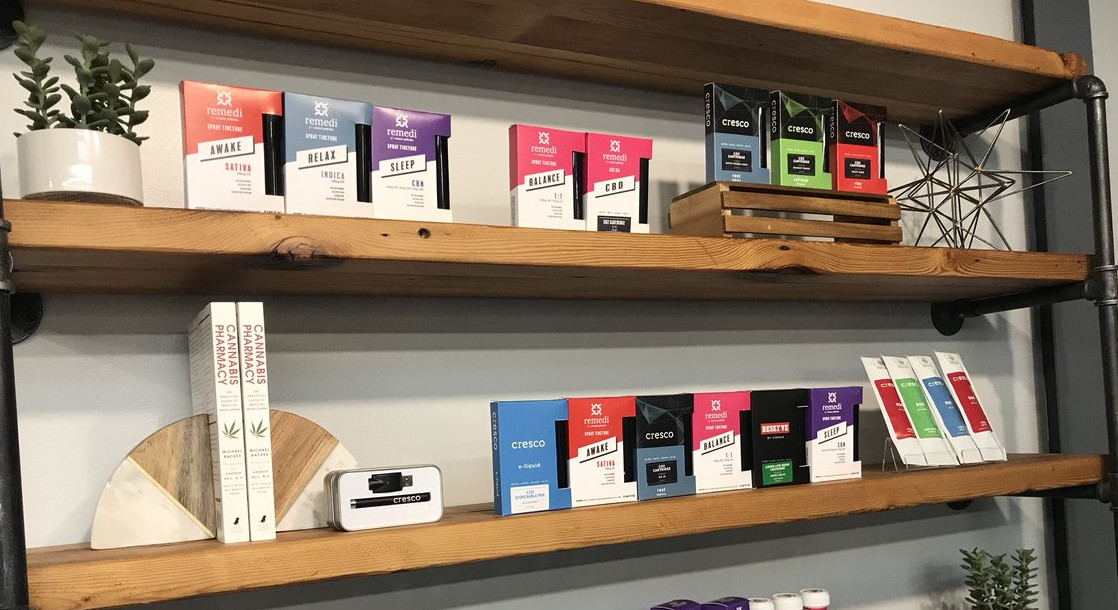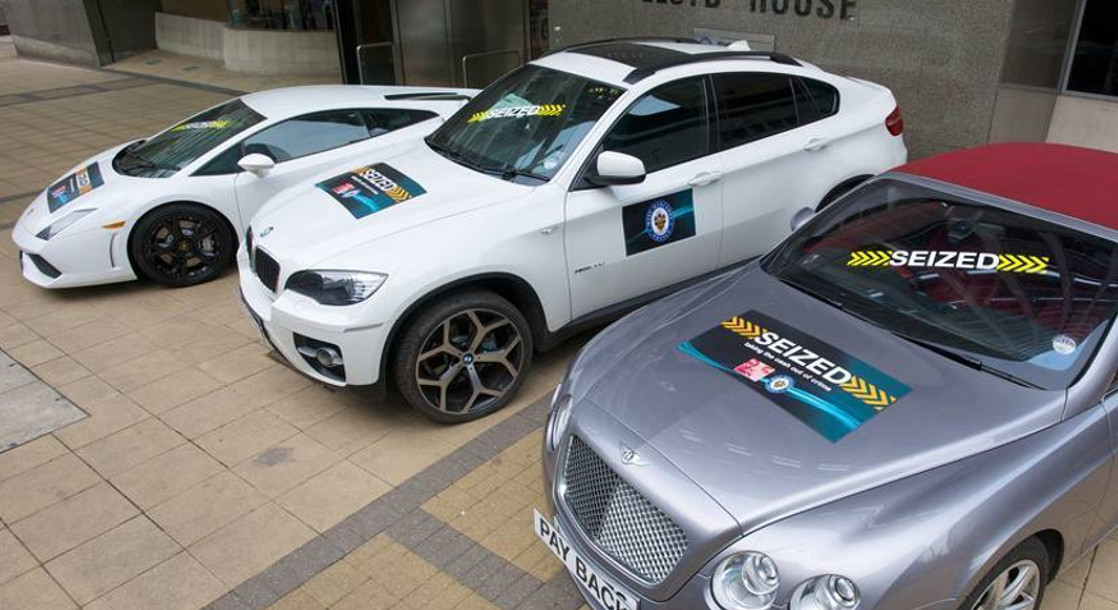Photos courtesy of The High Road Studio
When Megan Stone moved to California and became a medical cannabis patient in 2007, little did she know a random budtender job offer would eventually bloom into an award-winning design business. The High Road Studio, a design firm specializing in beautifying dispensaries, caught some critical applause when one client — Scottsdale, Arizona’s “premier medical dispensary” Level Up — took home the Best in Show award for Visual Merchandising & Store Design Magazine’s 23rd Annual International Visual Competition. But the work on Level Up is just part of what Stone and her team pulls off. The High Road Studio is responsible for bringing nuanced and smart design to dispensaries from San Diego to Tallahassee, including notable businesses like The Healing Center in San Diego and The Root Cellar in Washington.
Stone says she tries to bring a balance of masculine and feminine to her work, balancing out the traditionally hyper-masculine, sometimes-seedy feel that head shops can frequently embody. Design, she adds, should be a major consideration of cannabis entrepreneurs — especially for burgeoning dispensary businesses. A thoughtful and clean-looking space can help canna-businesses attract diverse clientele and progress the de-stigmatization of marijuana culture, especially in states like Florida where medicinal herb only recently became legal. MERRY JANE caught up with Stone to chat about her unique focus within the cannabis space, the strange shopping experiences she’s undergone while working with clients, and photographing Snoop Dogg’s butt print.
This interview has been edited for length and clarity…

Megan Stone, founder of The High Road Studio, photographed by Tien Frogget
MERRY JANE: Tell me a little bit about how you started The High Road Studio.
Megan Stone: I started the High Road Studio four years ago last month. I had been a budtender for the three years prior to starting that… I didn't come to this thinking that this was the path I was on. You know, I'd become a medical cannabis patient myself when I moved to California in 2007. When I went back to school for interior design in 2010 in Orange County, the dispensary I was going to as a patient asked me if I wanted a budtending job. I took it… it was really the timing of that and the experience of being in the industry when it was going through that kind of 2010 to 2013 [seachange] phase of not just being California or Colorado anymore, because Washington and Colorado legalized in late 2012. [The cannabis industry] was just kind of coming into its own.
I also saw the huge need that [going to] dispensaries had to be a better experience. Myself, personally, having shopped in dispensaries and worked in one, never really felt the comfort level I expected as a consumer or a shopper when I went to a dispensary. It was the coolest thing I thought you could ever walk into a store and buy — yet the experience of walking into a dispensary and buying cannabis was anything but the coolest thing you had ever done.
Yeah, it's interesting because I feel like a lot of those types of stores definitely have a sort of masculine or seedy vibe to it. Why do you think it's so important to have that smart, clean aesthetic in dispensaries?
For several reasons. One, it's really important that we use the retail stores and the cannabis industry as a catalyst for changing the perception and the stigma. Most people's first experiences with [legal] cannabis… are gonna happen at retail locations. And so it's the responsibility of these stores to portray professionalism, safety, security, a good experience, a positive memory, something that people can relate to and connect with. From a business standpoint, design is also super important to any retail business; it affects the way the store operates. It affects how profitable your store can be, and it affects the way people come in and shop it.
Definitely. How is designing a dispensary different than designing other retail spaces?
There's a lot of challenges dispensary operators face, and a lot you have to consider as the designer when you're building a dispensary. First off, you're designing a store that sells a product that's still federally illegal and cannot be purchased in any way other than with cash, most of the time. So right there, the security challenges and the compliance challenges that are presented around that have huge effects on the operational side of the design and the security side of the design.
Then you also have the fact that people come into these stores for medical purposes — and they're also coming in needing a huge amount of education on these products. Most people walk into a dispensary thinking that they're going to go in and buy joints or have a selection of flower. They're overwhelmed and surprised when they see the vast array of products that you can purchase at a dispensary now. The dispensary's job is also to provide an environment that fosters education and can provide for a nice, discreet, private conversation and consultation to happen.
Those things oftentimes are happening right alongside the transaction that's being executed by somebody who's very familiar with the experience. Dispensaries have a lot going on. They have to be able to provide for the most vulnerable customers who need private knowledge and extreme one-on-one educational consultation, and they also have to be able to provide for high volume and repeat customers who are familiar with the product and really want to kind of come in and get out… This is an industry that relies on its brick and mortar stores, and so these stores do double, triple, quadruple duty in meeting the needs of all the customers that they need to serve.

Arizona's Level Up dispensary, designed by The High Road Studio, photographed by Richard Cadan
How do you tailor design concepts for specific stores or even specific states? I was really excited to see that you did a shop in Tallahassee because I grew up there.
The way we design stores is all centered around the client's brand and what their vision for that experience is gonna be. I'm not the kind of designer who comes in and tells my clients how to do things. Our design process starts off with a very in-depth interview with the client. If we're not the ones responsible for crafting their brand identity — which is one of the services we provide and one of the services that we did for Level Up — we're oftentimes taking in their branding and trying to understand who they are and what they want to be. And then we build that brand and that experience and that vision into a physical space.
Definitely. How much of your own personal style dictates the design process?
There certainly is a level of it. My clients hire me because they like the work I've done before. [Sometimes] they need the expertise of somebody who has been a patient, who has worked in a dispensary, and who has designed these stores across the country to kind of lend some opinion and some insight — or they want a woman's perspective on it.
My personal aesthetic is certainly more modern and contemporary, but I really love to create a unique balance of masculine and feminine traits and kind of give the space some sexiness. I like contrast — not only with colors — but with materials and textures. I really like setting off deep, bold colors with white or black negative space, and kind of complementing things with metallics or stones or other natural finishes.
I try to blend that into what the client's brand says. Like in the case with Level Up, that aesthetic was really driven by the client's desire to have kind of a warm, welcoming traditional space that felt like a high-end custom home. That's where the crown molding and kind of the dark dusty greens and grays and the stack stone finishes came in. I made sure to balance that out with those white high gloss/really contemporary display cases and the polish chrome accents that we had throughout the space. As a result, the whole space wasn't this shroud of traditional, dark/rich ambience. Rather, it had some points of juxtaposition to make things interesting and unique.

Concentrate displays at the TrueMed dispensary in Phoenix, Arizona. Designed by The High Road Studio, photographed by Tien Frogget
You mentioned that you're a medical cannabis patient, but tell me a little bit about your personal history with marijuana.
I grew up in the Midwest, and it really wasn't until I got to college that I started really enjoying the regular use of cannabis. I didn't really notice at first, but I have always used cannabis differently than most of my friends have. A lot of my friends… would use it more in a recreational way. They weren't using it throughout the day to kind of enhance whatever experience they were having, and they certainly weren't using it to focus on a task at hand, like I oftentimes was.
It wasn't really until I moved out to California and I was pretty much living alone that [I began a new relationship with cannabis]. I spent a good two, two and half years pretty much by myself. That is really when my relationship with cannabis became deep. It became a daily part of my personal routine and kind of my psyche, and then it kind of hit a different of evolution when I started working at the dispensary.
How did working at dispensary affect your relationship with cannabis?
That was really the first time in my life that I was interacting on a daily basis with people who were using cannabis the same way I was. It was the first time I really developed a dialogue around how to use it as a medicine and as a wellness product, and it was the first time I really got to talk about my experience with the different strains and the effects of them and how it helped me, as well as use that knowledge to really help other people.
Now, as an entrepreneur and as a business owner and as a 30-something-year-old woman, I can't imagine how life would look today if I wasn't privileged enough to be able to use cannabis medicinally my whole adult life. It has replaced every pharmaceutical [and] most of the other vices that I have. I don't really drink that much anymore. Now, for me [cannabis is] a true mind, body, spirit thing — and it's a daily part of what keeps me centered and in the headspace that I want to be in.
I need to know more information about this Instagram with you and Snoop Dogg.
That was definitely a highlight of my professional and personal life. Shortly after Level Up opened last year, they kind of took advantage of the experience and the showcase dispensary that they have. So Snoop came through town, they landed an appearance with him at the shop. So I got to join Level Up and a bunch of their patients in meeting and greeting Snoop Dogg. It was really cool. I got to see Snoop signing autographs in a chair that I specced, in a lobby that I designed! I even have a photo of the butt print Snoop left on the velvet chair when he got up.
What's his butt like? What kind of print did it leave?
Small. He's really tall and skinny. It was small, but it was perfect. It was Snoop.

The Healing Center in San Diego, California, designed by The High Road Studio, photographed by Richard Cadan
So what's next for The High Road?
Well, we've had quite a year so far. My business continues to just explode. We have already accomplished in revenue this year what we did all last year combined, and we had hit that point already by June. The growth has allowed me to hire on my graphic designer and brand strategist full time. He's been freelancing for me for the past year and a half, taking on logo and brand identity work, as well as doing the environmental graphics and signage design and stuff that we do on our projects. With the advantage of having [a graphic designer] on board, now we are full-time offering branding services, graphic design services, visual merchandising, packaging design. When our clients come to us, they don't have to assemble a team of consultants outside of The High Road. We can provide all of that and keep it consistent and in line with their brand and wrap it all up into one nice little package.
[Branding is] certainly a focus for us for the rest of this year, as well as growing that side of our business. But long-term there are so many challenges and opportunities for design and design thinking within the cannabis retail experience, and even within the cannabis user experience. I look forward to lending my interpretation and my design aesthetic to things within that space.
Our neighbor to the north, Canada, is also getting ready to launch legalization nationwide next year — you bet that we will be up there making our mark on the retail scene with some pretty awesome store design up in Canada, as well.
That's awesome. Anything else that you think that people should know about The High Road or about you or about cannabis culture and dispensaries?
Design is such an important part of this industry right now. I think the biggest obstacle this industry faces is communicating who we really are and what the product really is, and design is such a powerful tool in changing the perceptions of what the product is and who the users of it are — and that's really the end goal that all of our endeavors focus on.
For more on The High Road Studio and Megan Stone, visit the company's website here and follow them on Instagram
Follow Beca Grimm on Twitter











